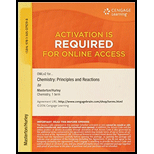
CHEMISTRY:PRIN.+REACTIONS-OWLV2 ACCESS
8th Edition
ISBN: 9781305079298
Author: Masterton
Publisher: Cengage Learning
expand_more
expand_more
format_list_bulleted
Concept explainers
Question
Chapter 21, Problem 36QAP
Interpretation Introduction
Interpretation:
To calculate the volume of chlorine required to oxidized all iodine.
Concept introduction:
The reaction of sodium iodide and chlorine is
After balancing the equation:
Expert Solution & Answer
Want to see the full answer?
Check out a sample textbook solution
Students have asked these similar questions
PROBLEM 12) Can you explain this problem and solve it correctly, please!
PROBLEM 9) Can you explain this problem and solve it correctly, please!
PROBLEM 17) Can you explain this problem and solve it correctly, please!
Chapter 21 Solutions
CHEMISTRY:PRIN.+REACTIONS-OWLV2 ACCESS
Ch. 21 - Prob. 1QAPCh. 21 - Prob. 2QAPCh. 21 - Prob. 3QAPCh. 21 - Prob. 4QAPCh. 21 - Prob. 5QAPCh. 21 - Prob. 6QAPCh. 21 - Give the formula for the acidic oxide of (a) HNO3...Ch. 21 - Prob. 8QAPCh. 21 - Write the formulas of the following compounds. (a)...Ch. 21 - Prob. 10QAP
Ch. 21 - Prob. 11QAPCh. 21 - Prob. 12QAPCh. 21 - Prob. 13QAPCh. 21 - Prob. 14QAPCh. 21 - Prob. 15QAPCh. 21 - Prob. 16QAPCh. 21 - Prob. 17QAPCh. 21 - Write a balanced net ionic equation for the...Ch. 21 - Prob. 19QAPCh. 21 - Prob. 20QAPCh. 21 - Prob. 21QAPCh. 21 - Prob. 22QAPCh. 21 - Prob. 23QAPCh. 21 - Prob. 24QAPCh. 21 - Prob. 25QAPCh. 21 - Prob. 26QAPCh. 21 - Prob. 27QAPCh. 21 - Prob. 28QAPCh. 21 - Prob. 29QAPCh. 21 - Prob. 30QAPCh. 21 - Prob. 31QAPCh. 21 - Prob. 32QAPCh. 21 - Prob. 33QAPCh. 21 - Prob. 34QAPCh. 21 - The average concentration of bromine (as bromide)...Ch. 21 - Prob. 36QAPCh. 21 - Iodine can be prepared by allowing an aqueous...Ch. 21 - Prob. 38QAPCh. 21 - Prob. 39QAPCh. 21 - Prob. 40QAPCh. 21 - Prob. 41QAPCh. 21 - Prob. 42QAPCh. 21 - Prob. 43QAPCh. 21 - Prob. 44QAPCh. 21 - Prob. 45QAPCh. 21 - Given...Ch. 21 - What is the concentration of fluoride ion in a...Ch. 21 - Calculate the solubility in grams per 100 mL of...Ch. 21 - Prob. 49QAPCh. 21 - Follow the directions for Problem 49 for the...Ch. 21 - Consider the equilibrium system HF(aq)H+(aq)+F(aq)...Ch. 21 - Applying the tables in Appendix 1 to...Ch. 21 - Consider the reaction 4NH3(g)+5O2(g)4NO(g)+6H2O(g)...Ch. 21 - Data are given in Appendix 1 for white phosphorus,...Ch. 21 - Prob. 55QAPCh. 21 - Prob. 56QAPCh. 21 - Sodium hypochlorite is produced by the...Ch. 21 - Prob. 58QAPCh. 21 - Prob. 59QAPCh. 21 - Prob. 60QAPCh. 21 - Consider the reduction of nitrate ion in acidic...Ch. 21 - Prob. 62QAPCh. 21 - Choose the strongest acid from each group. (a)...Ch. 21 - Prob. 64QAPCh. 21 - Prob. 65QAPCh. 21 - Prob. 66QAPCh. 21 - Prob. 67QAPCh. 21 - Prob. 68QAPCh. 21 - Prob. 69QAPCh. 21 - Explain why (a) acid strength increases as the...Ch. 21 - Prob. 71QAPCh. 21 - Prob. 72QAPCh. 21 - The amount of sodium hypochlorite in a bleach...Ch. 21 - Prob. 74QAP
Knowledge Booster
Learn more about
Need a deep-dive on the concept behind this application? Look no further. Learn more about this topic, chemistry and related others by exploring similar questions and additional content below.Similar questions
- Give the IUPAC name for the following alkenes. Include an E/Z designation where appropriate. Part 1 of 2 (E)-4,5-dimethylhept-2-ene Part 2 of 2 Sarrow_forwardAssign these cosyarrow_forwardDraw the major product of this reaction. Ignore inorganic byproducts. 1.LIAIH 2. H.O* Drawing NO. Q Searcharrow_forward
- Find a mole of : H2SO4 (15 ml 3.0 M) NaOH ( 18 mL 2.5 M) Acetic anhydride (3.0 mL)arrow_forwardFor the mechanism, show everything, lone paires, charges and arrow pleasearrow_forwardmolecule 0= OH ☐ ☐ type of molecule (check all that apply) fatty acid monoglyceride diglyceride triglyceride saturated unsaturated monounsaturated ☐ polyunsaturated ☐ ☐ ☐ ☐ ☐ 010 0 0 0 0 0 0 ☐ ☐ ☐ ☐☐☐☐ U omega-3 omega-6 fatty acid monoglyceride diglyceride triglyceride saturated unsaturated monounsaturated polyunsaturated omega-3 omega-6 fatty acid monoglyceride diglyceride triglyceride saturated unsaturated monounsaturated polyunsaturated omega-3 omega-6 OH OHarrow_forward
arrow_back_ios
SEE MORE QUESTIONS
arrow_forward_ios
Recommended textbooks for you
 Chemistry: Principles and ReactionsChemistryISBN:9781305079373Author:William L. Masterton, Cecile N. HurleyPublisher:Cengage Learning
Chemistry: Principles and ReactionsChemistryISBN:9781305079373Author:William L. Masterton, Cecile N. HurleyPublisher:Cengage Learning Chemistry: The Molecular ScienceChemistryISBN:9781285199047Author:John W. Moore, Conrad L. StanitskiPublisher:Cengage Learning
Chemistry: The Molecular ScienceChemistryISBN:9781285199047Author:John W. Moore, Conrad L. StanitskiPublisher:Cengage Learning ChemistryChemistryISBN:9781305957404Author:Steven S. Zumdahl, Susan A. Zumdahl, Donald J. DeCostePublisher:Cengage Learning
ChemistryChemistryISBN:9781305957404Author:Steven S. Zumdahl, Susan A. Zumdahl, Donald J. DeCostePublisher:Cengage Learning Chemistry: An Atoms First ApproachChemistryISBN:9781305079243Author:Steven S. Zumdahl, Susan A. ZumdahlPublisher:Cengage Learning
Chemistry: An Atoms First ApproachChemistryISBN:9781305079243Author:Steven S. Zumdahl, Susan A. ZumdahlPublisher:Cengage Learning
 Chemistry: Principles and PracticeChemistryISBN:9780534420123Author:Daniel L. Reger, Scott R. Goode, David W. Ball, Edward MercerPublisher:Cengage Learning
Chemistry: Principles and PracticeChemistryISBN:9780534420123Author:Daniel L. Reger, Scott R. Goode, David W. Ball, Edward MercerPublisher:Cengage Learning

Chemistry: Principles and Reactions
Chemistry
ISBN:9781305079373
Author:William L. Masterton, Cecile N. Hurley
Publisher:Cengage Learning

Chemistry: The Molecular Science
Chemistry
ISBN:9781285199047
Author:John W. Moore, Conrad L. Stanitski
Publisher:Cengage Learning

Chemistry
Chemistry
ISBN:9781305957404
Author:Steven S. Zumdahl, Susan A. Zumdahl, Donald J. DeCoste
Publisher:Cengage Learning

Chemistry: An Atoms First Approach
Chemistry
ISBN:9781305079243
Author:Steven S. Zumdahl, Susan A. Zumdahl
Publisher:Cengage Learning


Chemistry: Principles and Practice
Chemistry
ISBN:9780534420123
Author:Daniel L. Reger, Scott R. Goode, David W. Ball, Edward Mercer
Publisher:Cengage Learning